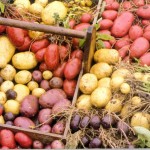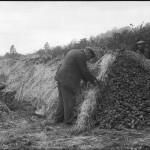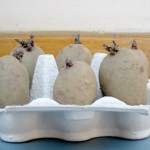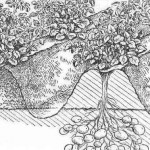What are potatoes?
This series will take you right through the whole process of knowing and growing potatoes. Potatoes are a tuberous and starchy crop that originate in the Andes and they are part of the nightshade family of plants. This tuber has been domesticated by people for around ten thousand years, Since the proliferation of the humble spud around the globe they have become a major component in the daily carbohydrate intake of peoples staple diets and are the worlds fourth largest crop following rice, wheat, and maize. In terms of their diversity there are about five thousands varieties of potatoes, around three thousand of them are still found and grown throughout Chile, Peru, Bolivia, Ecuador and Columbia. There are also around two hundred wild species of potatoes, some of which have been cross bred with cultivated varieties in order to bring about specific characteristics in the newly bred potato. There are about five-thousand potato varieties worldwide. Three thousand of them are found in the Andes alone, mainly in Peru, Bolivia, Ecuador, Chile and Colombia. They belong to eight or nine species, depending on the taxonomic school. Apart from the five-thousand cultivated varieties, there are about 200 wild species and subspecies, many of which can be cross-bred with cultivated varieties, which has been done repeatedly to transfer resistances to certain pests and diseases from the gene pool of wild species to the gene pool of cultivated potato species.
Why have potatoes become so popular?
Potatoes are easy to grow, they will tolerate a multitude of different climates, and very imortently in terms of human survival they can be stored under the right conditions throughout the winter months to give us a vital supply of food. Potatoes are packed with vitamins and nutrients and are a highly useful source of carbohydrates. Until fairly recently potatoes were a cheap and affordable food stuff but have risen in price due to the effects of our changing climate and stock market traders speculating on the price of food staples on the worlds Markets. Most of Europe and the Americas eat potatoes as a central part of their diet and it is estimated that in the US each person consumes around seventy kilograms of potatoes per year, where as in Europe the figure is twice that of the US with Europeans consuming around a hundred and forty kilos of potatoes per person per year. As with other food staples such as Maize rice and wheat, potatoes are very versatile and can cooked in every way imaginable.
Until fairly recently potatoes were a cheap and affordable food stuff but have risen in price due to the effects of our changing climate and stock market traders speculating on the price of food staples on the worlds Markets. Most of Europe and the Americas eat potatoes as a central part of their diet and it is estimated that in the US each person consumes around seventy kilograms of potatoes per year, where as in Europe the figure is twice that of the US with Europeans consuming around a hundred and forty kilos of potatoes per person per year. As with other food staples such as Maize rice and wheat, potatoes are very versatile and can cooked in every way imaginable.
Steve
Potatoes are not at all difficult to grow, they are usually one of the first vegetables that new gardeners experiment with growing when they start out on their gardening journey. I have grown potatoes myself on and off for around the last two decades and will share my tips and spud stories as we go along. There are many different ways of growing potatoes which gardeners and horticulturalists swear by, but before we look at these tried and tested methods we need to look at how we prepare our seed potatoes before planting them out
Chitting your seed potatoes
 Chitting potatoes as a method of allowing your seed potatoes to develop growths, simply sit your seed potatoes in a box, on a window sill, and they will begin to sprout.Some people do not bother chitting potatoes and still obtain a crop, I always chit mine and seem to get a good crop from them. Chitting usually takes place around the middle of January onwards, this give the seed potatoes plenty of time to develop their growths before being planted out in mid March.
Chitting potatoes as a method of allowing your seed potatoes to develop growths, simply sit your seed potatoes in a box, on a window sill, and they will begin to sprout.Some people do not bother chitting potatoes and still obtain a crop, I always chit mine and seem to get a good crop from them. Chitting usually takes place around the middle of January onwards, this give the seed potatoes plenty of time to develop their growths before being planted out in mid March.
Where, and how to grow your potatoes
There is no uniform of growing potatoes, agriculture grows in soil that is basically dead of all goodness and nutrients, kept alive only by the application of numerous chemical fossil fuel inputs, gardeners however adopt a number of different approaches and methods to potato cultivation
Growing in soil – the chatted seed potatoes are buried around three to five in inches deep in the soil, and should be placed at intervals of around sixteen inches apart. Using this method more soil is added around the plant as it begins to grow, this is called banking up or earthing up and it helps the plant to grow more potatoes. Potatoes like a generally healthy soil to thrive in, though they tolerant of a variety of soil types, and can even help to break up soil with a fairly heavy clay content. 
No dig method – this method is no dig because it means just that, there is no digging inolved whatsoever, this method preserves and improves the soils nutrient levels and overall quality. Prepare your growing area by covering with sheets of newspaper and cardboard, then build up layers of organic matter, keep on adding, compost, straw, grass cuttings, plant your seed potatoes inside the layers that you have built up and water, let the bed settle down for a week and add more straw and grass cuttings.
Growing in straw – growing potatoes in straw is a relation of the no dig method in that there is no actual digging required in the process of planting and growing the potatoes, using this method potatoes are grown either in containers of mulched beds and covered with layers of straw and scatterings of compost
Growing in containers – Growing potatoes in containers has become a popular method due to the fact that container growing doesnt take up much space for those with smaller gardens of yards. potatoes can be grown in large potatoes and ventilated sacks, fill your container with around four inches of soil, add the seed potatoes, cover with two inches of soil, and keep adding soil as the plant produces more green growth, this will help provide you with more potatoes, I usually cover mine once a week whilst they are growing, leaving the top leaves sticking through, I will probably do this for around a month to six weeks on a once weekly basis before leaving them to grow on for the remainder of their time until cropping. 
